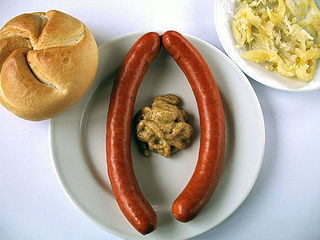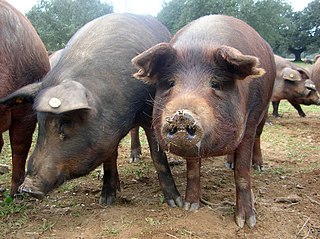
Hungarian or Magyar cuisine is the cuisine characteristic of the nation of Hungary, and its primary ethnic group, the Magyars. Hungarian cuisine has been described as being the spiciest cuisine in Europe. This can largely be attributed to the use of their piquant native spice, Hungarian paprika, in many of their dishes. A mild version of the spice, Hungarian sweet paprika, is commonly used as an alternative. Traditional Hungarian dishes are primarily based on meats, seasonal vegetables, fruits, bread, and dairy products.

Tripe is a type of edible lining from the stomachs of various farm animals. Most tripe is from cattle, pigs and sheep.

Goulash is a soup or stew of meat and vegetables seasoned with paprika and other spices. Originating in Hungary, goulash is a common meal predominantly eaten in Central Europe but also in other parts of Europe. It is one of the national dishes of Hungary and a symbol of the country.

Offal, also called variety meats, pluck or organ meats, is the internal organs of a butchered animal. The word does not refer to a particular list of edible organs, and these lists of organs vary with culture and region, but usually exclude skeletal muscle. Offal may also refer to the by-products of milled grains, such as corn or wheat.
Romanian cuisine is a diverse blend of different dishes from several traditions with which it has come into contact, but it also maintains its own character. It has been mainly influenced by Turkish and a series of European cuisines in particular from the Balkans, or Hungarian cuisine as well as culinary elements stemming from the cuisines of Central Europe.

Liptauer is a spicy cheese spread from Slovak, Austrian and Hungarian cuisine. Liptauer is made with sheep milk cheese, goat cheese, quark, or cottage cheese.

Bulgarian cuisine is part of the cuisine of Southeast Europe, sharing characteristics with other Balkan cuisines. Bulgarian cooking traditions are diverse because of geographical factors such as climatic conditions suitable for a variety of vegetables, herbs, and fruit. Aside from the variety of local Bulgarian dishes, Bulgarian cuisine shares a number of dishes with its neighboring countries, in particular with the Turkish and Greek cuisine.

Pörkölt is a meat stew which originates from Hungary, but is eaten throughout Central Europe.

Czech cuisine has both influenced and been influenced by the cuisines of surrounding countries and nations. Many of the cakes and pastries that are popular in Central Europe originated within the Czech lands. Contemporary Czech cuisine is more meat-based than in previous periods; the current abundance of farmable meat has enriched its presence in regional cuisine. Traditionally, meat has been reserved for once-weekly consumption, typically on weekends.

Lecsó is a Hungarian thick vegetable ragout or stew which traditionally contains yellow pointed peppers, tomato, onion, salt, and ground sweet and/or hot paprika as a base recipe. The onions and peppers are usually sauteed in lard, bacon fat, or sunflower oil. Garlic can also be a traditional ingredient. It is also considered to be traditional food in Czech, Slovak and former Yugoslavian cuisine and is also very common in Poland, Austria, and Israel.

Bosnian cuisine is the traditional cuisine of Bosnia and Herzegovina. It is influenced by Ottoman, Austro-Hungarian and Balkan cuisines.

A debrecener is a pork sausage of uniform fine texture and reddish-orange colour, named after the Hungarian city of Debrecen. The sausages are heavily spiced with paprika and other seasonings like garlic, pepper and marjoram. Usually they contain tiny pieces of pork fat as well. They are usually unsmoked or lightly smoked, and sold in pairs joined at one end. Traditional cooking technique calls for the Debreceni to be transversely slashed at intervals and baked, broiled, or fried. The sausage tends to curl away from the slashes, creating a linked series of sausage coins.

Extremadura, Spain is known for its different ways of preparing the Iberian pork and mutton. The main characteristics of the traditional Extremaduran cuisine are its simplicity, its lack of clutter and its low cost. It is also a cuisine reflecting a generous spirit, for many of its preparations used to be cooked in large pots to share with visitors, friends, and neighbors. The resulting dishes are eaten with local bread.

Főzelék is a type of thick Hungarian vegetable stew or soup, similar to pottage. Főzelék is a special category in Hungarian cuisine, not quite like a soup, and thinner than a stew. It is simply cooked, typically by simmering, not mashing. It is usually not cooked with meat, but bacon and spicy sausage may be added for flavor. Főzelék is often eaten as the main course for lunch or like a garnish for different meat courses. Főzelék was typically a home-made food, and was considered as an ordinary type of meal so traditionally it seldom appeared on restaurant menus but in recent years, as part of the culinary revolution in Hungary, főzelék enjoys a revival and it is much more common to be found on menus, there are even places dedicated to offering various főzelék as main course.

Kielbasa is any type of meat sausage from Poland and a staple of Polish cuisine. It is also known in other world cuisines; in American English, the word typically refers to a coarse, U-shaped smoked sausage of any kind of meat, which closely resembles the Wiejskasausage.

A stew is a combination of solid food ingredients that have been cooked in liquid and served in the resultant gravy. Ingredients can include any combination of vegetables and may include meat, especially tougher meats suitable for slow-cooking, such as beef, pork, venison, rabbit, lamb, poultry, sausages, and seafood. While water can be used as the stew-cooking liquid, stock is also common. A small amount of red wine or other alcohol is sometimes added for flavour. Seasonings and flavourings may also be added. Stews are typically cooked at a relatively low temperature, allowing flavours to mingle.

Fisherman's soup or halászlé is a hot, spicy paprika-based fish soup. A folk item of Hungarian cuisine, it is a bright-red hot dish prepared with generous amounts of hot paprika and carp or mixed river fish. It is native to the Pannonian Plain, particularly the Danube and Tisza river regions. It is also a popular dish among ethnic German Donauschwaben and their descendants, known as Karpfensuppe. In Croatia, it is commonly served in the regions of Slavonia and Baranya, where it is called fiš paprikaš.



















